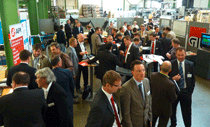Plastics in automotive: Warm welcome for Varysoft molding technique
Injection molder Muffler-Plastic tooled out one of its Krauss-Maffei presses with a mold from Swiss moldmaker Georg Kaufmann Formenbau to demonstrate to automotive industry experts the Varysoft technique for back molding of decorative films onto a soft-touch foam. The technology is expected to see use in interior trim, armrests and maybe much more.
May 12, 2010
Injection molder Muffler-Plastic tooled out one of its Krauss-Maffei presses with a mold from Swiss moldmaker Georg Kaufmann Formenbau to demonstrate to automotive industry experts the Varysoft technique for back molding of decorative films onto a soft-touch foam. The technology is expected to see use in interior trim, armrests and maybe much more.
We first reported on the Varysoft molds from Kaufmann last September in this article. The technique makes use of a mold with two cavities, one for the conventional injection molding of a supporting structure (such as polypropylene) and one for preforming of a decorative material—film, fabric, or imitation leather. For the foam layer, the machine needs either an additional injection unit for expandable thermoplastic elastomer (TPE) or a polyurethane (PUR) processing unit with PUR mixing head.
The invite from German injection molder Muffler-Plastic GmbH (Pfullendorf) to see one of the molds in progress was accepted by about 50 automotive industry insiders, who recently visited its facility for a demonstration of the Varysoftprocess. Representatives of the Swiss moldmaker also were present (that's them in the photo in the red ties; Roger Kaufmann, son of founder Georg, is in the enter facing to his left).
The sample part molded at Muffler-Plastic for the demonstration featured the tight radii and complex surface geometry typical of the difficulties encountered in the production of passenger compartment trim. It included a PP supporting structure with its soft foam layer an expandable thermoplastic elastomer (TPE). The decorative materials used varied between relatively thin TPE sheet, relatively thick TPE sheet and alcantara sheet.
|
The mold used for the demonstration, built by Kaufmann and equipped with a vertically sliding table, was mounted on a 650-tonne Krauss-Maffei two-component injection molding machine. One injection unit injected the material for the supporting structure (PP); the other injected the expandable TPE. For the purpose of the demonstration, one of the processor's employees handled manual insertion of the decorative material and removal of the finished part, but clearly automation would be used in a 'real' molding cell. Manual insertion and removal had the added benefit that visitors could easily observe the individual sequences of the process.
Roger Kaufmann, R&D director and sales manager at the moldmaker, commented, "For us the demonstration of our Varysoft process was an enormous success and an important further step towards a more intensive development of the market. Visitors from important car manufacturing companies and automotive supply companies could see for themselves how simple the process actually is." According to Markus Haller, Kaufmann's marketing manager at Kaufmann, automotive OEM has asked the company to run the numbers on a mold for a passenger compartment component based on a comparison of the current manufacturing costs and those using a Varysoft mold.
The host of the event, Tobias Muffler, managing director of Muffler-Plastic, expects the development to find plenty of takers. "We are convinced that the Varysoft process offers enormous potential when it comes to the development and production of molded parts for car interiors. And we expect that this technology will really come into its own—slowly but surely—in mass production, initially for relatively small production runs or for special luxury car models," and eventually also for all mid-range cars, he said. He also foresees the technology's potential use in applications in commercial vehicles, in the furniture and electrical engineering industries and in the sports and household appliance industries.
About the Author(s)
You May Also Like



